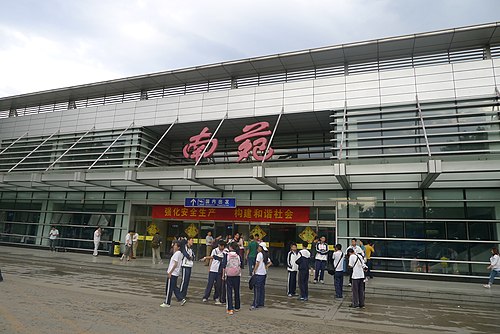This articleneeds additional citations forverification. Please helpimprove this article byadding citations to reliable sources. Unsourced material may be challenged and removed. Find sources: "Beijing Nanyuan Airport" – news ·newspapers ·books ·scholar ·JSTOR(January 2020) (Learn how and when to remove this message) |
Beijing Nanyuan Airport 北京南苑机场 | |||||||||||
|---|---|---|---|---|---|---|---|---|---|---|---|
 | |||||||||||
| Summary | |||||||||||
| Airport type | Defunct | ||||||||||
| Location | Fengtai,Beijing,China | ||||||||||
| Opened | 1910 (1910) | ||||||||||
| Closed | 30 September 2019 (2019-09-30) (military) | ||||||||||
| Passenger services ceased | 25 September 2019 (2019-09-25) | ||||||||||
| Operating base for | China United Airlines(1986–2019) | ||||||||||
| Coordinates | 39°47′03″N116°23′39″E / 39.7842°N 116.3943°E /39.7842; 116.3943 | ||||||||||
| Map | |||||||||||
| Runways | |||||||||||
| |||||||||||
| Statistics (2018) | |||||||||||
| |||||||||||
| Beijing Nanyuan Airport | |||||||||||||||
|---|---|---|---|---|---|---|---|---|---|---|---|---|---|---|---|
| Simplified Chinese | 北京南苑机场 | ||||||||||||||
| Traditional Chinese | 北京南苑機場 | ||||||||||||||
| Literal meaning | "South Garden Airport"[1] | ||||||||||||||
| |||||||||||||||
Beijing Nanyuan Airport (IATA:NAY,ICAO:ZBNY) was aPeople's Liberation Army Air Force Base and a secondary commercial airport ofBeijing, the capital ofChina. Located inFengtai District, 3 km (1.9 mi) south of the4th Ring Road and 13 km (8.1 mi) fromTiananmen Square,[2] Nanyuan Airport was first opened in 1910, making it the oldest airport in China. It was the main operating base forChina United Airlines, which was also the airport's sole airline.[3]
Nanyuan Airport ceased civil operations on 25 September 2019, after all commercial passenger flights (operated byChina United Airlines) were moved to the newly openedBeijing Daxing International Airport.[3] It remained operational as aPeople's Liberation Army Air Force military base for 5 more days until 30 September 2019, when theBeijing Nanjiao Airport [zh] (known as "New Nanyuan Airport" during construction, adjacent to Beijing Daxing Airport) opened.
The first aircraft landed in the Nanyuan area in 1904. In July 1907, the government built rudimentary runways in Nanyuan's Yijun training ground (also known as the Wulidian soldier training ground) and used it for a light aircraft purchased from France.[4]
In August 1910, theQing government began to establish air transportation in China with the construction of a factory in Nanyuan to experiment with manufacturing aircraft, thereby officially opening the Nanyuan airport for regular use.[5] Nanyuan airport was the first airport in China and one of the threeoperational airports opened before 1910s in the world.[citation needed] After theXinhai Revolution,Yuan Shikai, who followed suggestions from the French advisers, established the first official flying academy in China in 1913,Nanyuan Flying Academy, withLi Ruyan as chief, and purchased 10 FrenchCaudron trainer aircraft for 300,000 silver dollars.[citation needed] After theSecond Zhili–Fengtian War, the academy was closed. However, the more than 100 pilots that trained in the academy over 4 terms have played important roles in China's aviation history. Later on, some of them become key persons in civil aviation.[citation needed][vague]
In the brief episode of theManchu Restoration led by Qing loyalist generalZhang Xun in July 1917, then-PremierDuan Qirui ordered aCaudron Type D aircraft piloted by Pan Shizhong (潘世忠) and bombardier Du Yuyuan (杜裕源) of the country'sfledgling air force based in Nanyuan to fly to and drop bombs over the Forbidden City; three bombs were dropped, causing the death of a eunuch but otherwise minor damage.[6]
During theSino-Japanese War, theJapanese Army extended the airport, upgraded its air traffic control facilities, and changed the name to Nanyuan military camp.[citation needed] After thesurrender of Japan in 1945, Nanyuan Airport became one of the most important airports for theNationalist government and itsair force.[citation needed] The private planes ofChiang Kai-shek andFu Zuoyi have taken off from the Nanyuan Airport; many ofKuomintang's important military and government personnel have also boarded flights from Nanyuan.[citation needed] ACurtiss C-46 Commando alsocrashed near the airport in 1945.
During 1946United States Marine Corps fighter squadronVMF-218 was based here.[7]
In December 1948, thePeople's Liberation Army took control of the airport.[citation needed] In August 1949, the first flying brigade of thePeople's Liberation Army Air Force was formed here and they participated in thePeople's Republic of China Founding Ceremony's flying missions.[citation needed] Since then, Nanyuan Airport has been supporting the training of air and ground forces in all of the subsequentNational Day Show of Force events.[citation needed]
In 1986,China United Airlines was established as a military-owned civil airline with special authorization to use military airports.[citation needed] Becoming the first commercial airline to serve Nanyuan, it turned the airbase into its mainhub.[citation needed] It has continued to operate out of the airbase despite its 2004 privatization and sale toShanghai Airlines.[citation needed]
In 2008, Nanyuan Airport witnessed a high growth rate. The total number of passengers served increased by 80.1%, reaching 1,357,038; total freight loaded/unloaded reached 13,243 tonnes, which was a 67% increase from the previous year. Traffic movements also had a very strong growth rate of 72.2%, registering 12,245.[8]
Nanyuan Airport opened a new terminal in September 2013 with a designed passenger handling capacity of 6 million people.[9] The previous terminal was capable of handling 2.8 million passengers during 2011.[citation needed]
Nanyuan ceased civil operation on 25 September 2019 after all commercial passenger flights were moved to the newly openedBeijing Daxing International Airport.[3] It remained operational as aPeople's Liberation Army Air Force air base until late September 2019, when theBeijing Nanjiao Airport [zh] (known as "New Nanyuan Airport" during construction) opened.
段祺瑞下令叫南苑航空学校出动一架飞机去轰炸紫禁城。南苑航空学校并无正式的轰炸机,不过既然段祺瑞只是希望吓唬一下溥仪和张勋,要求不高,所以最后派了一架高德隆双翼飞机去执行轰炸任务。飞机由教官潘世忠驾驶,而投弹员则是杜裕源,据杜裕源回忆,因为没有瞄准设备,因此在紫禁城他是随意投下了3枚小炸弹,并没有针对特定目标。投下的炸弹中一枚还是哑弹,一共只炸死了一个太监,此外部分建筑物受到了一点小损伤。